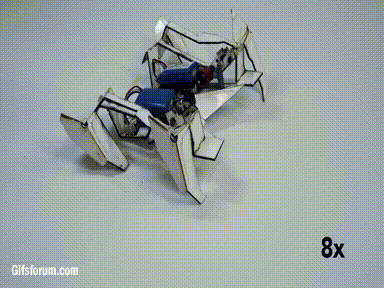Flat-packed, self-folding, robot origami
 In an automated, robotic future, the common task of folding origami may no longer exist.
In an automated, robotic future, the common task of folding origami may no longer exist.
Researchers in the US have developed a new style of self-folding origami-based robot, which can transform itself from a flat-pack to a functional shape.
Possible applications include machines for search-and-rescue scenarios, where they could be slid into small areas and activated to navigate internal spaces or tunnels.
Some embedded mechanics and electronics help coax the flat sheets of composite materials to fold themselves into complex robots that can creep and crawl their way to a range of tasks.
The robots self-assemble from flat sheets of paper and shape memory polymers, which change shape when heated above 100Ëš Celsius.
The origami-bots can transform in about four minutes, crawl at a speed of about 5.4 centimetres per second, and also turn itself around.
No self-folding approach has previously yielded such a functional and mobile machine.
The approach is both efficient and versatile, allowing researchers to quickly produce complex robots that can be scaled to different sizes and are very strong for their weight, a new study from Harvard and MIT reports.
The research will be formally presented at the Sixth International Meeting on Origami in Science, Mathematics and Education, 10-13 August, in Tokyo.
There are a number of manufacturing advantages for foldable automatons.
“Folding allows you to avoid the ‘nuts and bolts’ assembly approaches typically used for robots or other complex electromechanical devices,” said Harvard research engineer Rob Wood.
“And it allows you to integrate components (such as electronics, sensors and actuators) while flat.”
Many of the pieces are made simply by cutting their outlines out of flat sheets.
“Traditional manufacturing requires expensive machinery, and 3D printing is too slow for mass production, but planar composites can be rapidly built with inexpensive tools like laser cutters and etch tanks, and then folded into functional machines. Such manufacturing methods would be ideal for producing 100-1000 units,” said PhD candidate Sam Felton.
The robots feature some pretty tricky self-folding hinges, too.
The hinges contain embedded heating circuits that create the heat necessary to activate folding.
The placement of the hinges in the composite and the order in which they are triggered creates a fold pattern that determines the final shape of the 3-D structure.
3-D design software is used to generate detailed crease patterns in the polymer material, which automate the folding process as efficiently as possible.
It can even form creases that become connected in cyclic folds, or a collection of creases.
“Cyclic folds are used... as building blocks to create any polyhedron,” explained Felton.
“We've discovered that we can [use this approach] to create a wide variety of structures and machines.”
“When incorporated into more complex devices, these materials will enable on-the-fly transformation of mechanical function,” says Cornell researcher Jesse Silverberg.
“We envision combining these origami-inspired materials with computer-controlled actuators to build more complex machines, such as hardening shells, locked-in joints and deployable barriers.”
“Ultimately, this transformer technology will revolutionise the way we think about materials, moving them beyond their current static form, and revealing more functionality than what originally meets the eye.”







 Print
Print